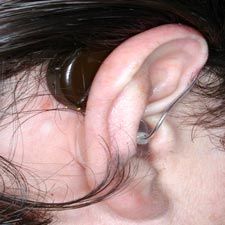Open Wide and Listen!
February 16, 2010 | dlpmagazine.com web exclusive Open Wide and Listen! Dentists play key role in a new bone conduction technology that helps the deaf hear.
February 16, 2010 | dlpmagazine.com
web exclusive
Open Wide and Listen!
Dentists play key role in a new bone conduction technology that helps the deaf hear.
by Pam Johnson, Editor-in-Chief

The BTE is worn behind the ear.
Ever wonder why the speaking voice you hear when you talk sounds nothing like your voice on the answering machine? That’s because when you speak you are not hearing your voice with your ears; you are hearing it through what is called bone conduction. The same thing happens when you scratch your head or brush your teeth. Sound vibrations are carried not through the air and to your ears but rather through the bone and teeth to the cochleae in your inner ear, allowing you to hear these sounds.
It’s this natural phenomenon that led Amir Abolfathi, former Vice President of R&D of Align Technologies, makers of Invisilgn braces, to form Sonitus Medical and develop the SoundBite hearing system. This non-surgical and removable device is intended to restore the hearing in patients affected by single-sided deafness, conductive hearing loss, or mixed hearing loss by transmitting sound through the teeth.
“We’re conducting clinical trials now,” said Vice President of Marketing, Jason Shelton. “We hope to get FDA approval by sometime this summer.”
What’s different about the SoundBite system and what makes it unique is that no surgery is involved in placement of the device. Shelton explained that the current treatment being used to help the single-sided deaf hear is a bone-anchored hearing device that requires surgically implanting a titanium post into the skull just behind the ear and after healing attach to it an external transducer box that patients wear behind the ear.
“We believed we could develop a non-invasive device that would use the same bone-conducting principle,” he said.
What researchers and engineers at Sonitus Medical developed is the first wireless, non-surgical and removable bone conduction hearing system designed to transmit sound via the teeth. A small microphone unit (BTE), housing the receiver and wireless transmitter is worn behind the ear and a discreet, removable hearing device (ITM) is placed onto a natural tooth, crown, or implant in the mouth. A tiny microphone inside an open-fit dome is worn in the affected ear, attached by a thin tube to the BTE. Sound is wirelessly transmitted from the behind-the-ear microphone to the ITM on the tooth. The ITM creates imperceptible vibrations that are carried through the teeth and bone and picked up by the cochlea of the patient’s good ear. Shelton said the device is intended to have broad frequency response range from 500 Hz to 12,000 Hz which will give patients the perception of normal spatial sound hearing.

“The sound is coming in through the bad ear, traveling through the teeth and bone to the cochlea of the good ear,” said Shelton. He’s seen patients in the clinical trial wearing the device light up with delight when someone whispers in their previously deaf ear.
Patients wearing the intraoral device can still eat and drink normally since the ITM does not cover the occlusal surface of the tooth. Shelton said patients who have been fitted with the device say they normally chew on the opposite side and then remove the device for cleaning afterward.
So what does all this have to do with dentistry? Patients who are candidates to receive the SoundBite system must first go through a dental exam to assess oral health and an impression of the upper arch taken in order for the company to custom design the intraoral ITM device. Shelton said the dentist referral most likely would be coming from an Ear, Nose & Throat specialist who would be the primary treating physician. Or dentists interested in “helping patients rejoin the conversation of life” can contact Sonitus Medical through the company web site: www.sonitusmedical.com.
Pamela Johnson is editor-in-chief for DLP. Contact her at pjohnson@advanstar.com.
Join the Discussion
- Comment on this and other articles on our Facebook page